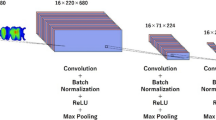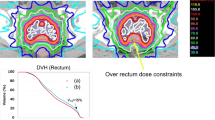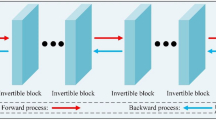Abstract
To predict the gamma passing rate (GPR) of the three-dimensional (3D) detector array-based volumetric modulated arc therapy (VMAT) quality assurance (QA) for prostate cancer using a convolutional neural network (CNN) with the 3D dose distribution. One hundred thirty-five VMAT plans for prostate cancer were selected: 110 plans were used for training and validation, and 25 plans were used for testing. Verification plans were measured using a helical 3D diode array (ArcCHECK). The dose distribution on the detector element plane of these verification plans was used as input data for the CNN model. The measured GPR (mGPR) values were used as the training data. The CNN model comprises eighteen layers and predicted GPR (pGPR) values. The mGPR and pGPR values were compared, and a cumulative frequency histogram of the prediction error was created to clarify the prediction error tendency. The correlation coefficients of pGPR and mGPR were 0.67, 0.69, 0.66, and 0.73 for 3%/3-mm, 3%/2-mm, 2%/3-mm, and 2%/2-mm gamma criteria, respectively. The respective mean±standard deviations of pGPR-mGPR were -0.87±2.18%, -0.65±2.93%, -0.44±2.53%, and -0.71±3.33%. The probabilities of false positive error cases (pGPR < mGPR) were 72%, 60%, 68%, and 56% for each gamma criterion. We developed a deep learning-based prediction model of the 3D detector array-based VMAT QA for prostate cancer, and evaluated the accuracy and tendency of prediction GPR. This model can provide a proactive estimation for the results of the patient-specific QA before the verification measurement.







Similar content being viewed by others
References
Chow JC, Jiang R (2013) Prostate volumetric-modulated arc therapy: dosimetry and radiobiological model variation between the single-arc and double-arc technique. J Appl Clin Med Phys 14(3):3–12
Gorayski P, Fitzgerald R, Barry T et al (2014) Volumetric modulated arc therapy versus step-and-shoot intensity modulated radiation therapy in the treatment of large nerve perineural spread to the skull base: a comparative dosimetric planning study. J Med Radiat Sci 61(2):85–90
Ezzell GA, Burmeister JW, Dogan N et al (2009) IMRT commissioning: multiple institution planning and dosimetry comparisons, a report from AAPM Task Group 119. Med Phys 36:5359–5373
Ezzell GA, Galvin JM, Low D et al (2003) Guidance document on delivery, treatment planning, and clinical implementation of IMRT: report of the IMRT subcommittee of the AAPM radiation therapy committee. Med Phys 30:2089–2115
Hartford AC, Galvin JM, Beyer DC et al (2012) American College of Radiology (ACR) and American Society for Radiation Oncology (ASTRO) practice guideline for intensity-modulated radiation therapy (IMRT). Am J Clin Oncol 35:612–617
Van Esch A, Bohsung J, Sorvari P et al (2002) Acceptance tests and quality control (QC) procedures for the clinical implementation of intensity modulated radiotherapy (IMRT) using inverse planning and the sliding window technique: experience from five radiotherapy departments. Radiother Oncol 65:53–70
Bedford JL, Warrington AP (2009) Commissioning of volumetric modulated arc therapy (VMAT). Int J Radiat Oncol Biol Phys 73(2):537–545
Ling CC, Zhang P, Archambault Y et al (2008) Commissioning and quality assurance of RapidArc radiotherapy delivery system. Int J Radiat Oncol Biol Phys 72(2):575–581
García-Vicente F, Fernández V, Bermúdez R et al (2012) Sensitivity of a helical diode array device to delivery errors in IMRT treatment and establishment of tolerance level for pretreatment QA. J Appl Clin Med Phys 13(1):111–123
McNiven AL, Sharpe MB, Purdie TG (2010) A new metric for assessing IMRT modulation complexity and plan deliverability. Med Phys 37:505–515
Masi L, Doro R, Favuzza V, Cipressi S, Livi L (2013) Impact of plan parameters on the dosimetric accuracy of volumetric modulated arc therapy. Med Phys 40:071718
Wang J, Jin X, Peng J, Xie J, Chen J, Hu W (2016) Are simple IMRT beams more robust against MLC error? Exploring the impact of MLC errors on planar quality assurance and plan quality for different complexity beams. J Appl Clin Med Phys 17:147–157
Sumida I, Yamaguchi H, Das IJ et al (2017) Organ-specific modulation complexity score for the evaluation of dose delivery. J Radiat Res 58:675–684
Shiba E, Saito A, Furumi M et al (2019) Predictive gamma passing rate by dose uncertainty potential accumulation model. Med Phys 46:999–1005
Shiba E, Saito A, Furumi M et al (2020) Predictive gamma passing rate for three-dimensional dose verification with finite detector elements via improved dose uncertainty potential accumulation. Med Phys 47:1349–1356
Interian Y, Rideout V, Kearney VP et al (2018) Deep nets vs expert designed features in medical physics: an IMRT QA case study. Med Phys 45:2672–2680
Tomori S, Kadoya N, Takayama Y et al (2018) A deep learning-based prediction model for gamma evaluation in patient-specific quality assurance. Med Phys 45:4055–4065
Masi L, Casamassima F, Doro R, Francescon P (2011) Quality assurance of volumetric modulated arc therapy: evaluation and comparison of different dosimetric systems. Med Phys 38:612–621
Feygelman V, Zhang G, Stevens C, Nelms BE (2011) Evaluation of a new VMAT QA device, or the “X” and “O” array geometries. J Appl Clin Med Phys 12:146–168
Miften M, TH-A-BRC-03: (2016) AAPM TG218: measurement methods and tolerance levels for patient-specific IMRT verification QA. Med Phys 43:3852–3853
Low DA, Harms WB, Mutic S, Purdy JA (1998) A technique for the quantitative evaluation of dose distributions. Med Phys 25:656–661
Nair V, Hinton GE (2010) Rectified linear units improve restricted Boltzmann machines. Proc. 27th Int’l Conf Mach Learn. :807–814
Srivastava N, Hinton G, Krizhevsky A, Sutskever I, Salakhutdinov R (2014) Dropout: a simple way to prevent neural networks from overfitting. J Mach Learn Res 15:1929–1958
Deep learning for humans. https://github.com/fchollet/keras
Abadi M, Agarwal A, Barham P et al(2016) Tensorflow: Large-scale machine learning on heterogeneous distributed systems.arXiv preprint arXiv:160304467.
Kingma DP, Ba LJ (2014) ADAM: A method for stochastic optimization. ICLR. (arXiv:1412.6980)
Ono T, Hirashima H, Iramina H et al (2019) Prediction of dosimetric accuracy for VMAT plans using plan complexity parameters via machine learning. Med Phys 46:3823–3832
Li J, Wang L, Zhang X et al (2019) Machine learning for patient-specific quality assurance of VMAT: Prediction and classification accuracy. Int J Radiation Oncol Biol Phys 105(4):893–902
Chun M, Kim JI, Oh DH et al (2020) Effect of dose grid resolution on the results of patient- specific quality assurance for intensity-modulated radiation therapy and volumetric modulated arc therapy. Int J Radiat Res 18(3):521–530
Sakai M, Nakano H, Kawahara D et al (2021) Detecting MLC modeling errors using radiomics-based machine learning in patient-specific QA with an EPID for intensity-modulated radiation therapy. Med Phys 48(3):991–1002
Funding
The authors declare that no funds, grants, or other support were received during the preparation of this manuscript.
Author information
Authors and Affiliations
Contributions
All authors contributed to the study conception and design. Material preparation, data collection and analysis were performed by TM. The first draft of the manuscript was written by TM and all authors commented on previous versions of the manuscript. All authors read and approved the final manuscript.
Corresponding author
Ethics declarations
Conflict of interest
The authors declare that they have no conflict of interest to disclose.
Presentation
None.
Ethics approval
Institutional Review Board Statement: This study was approved by the Institutional Review Board of Hiroshima University Hospital (IRB number: E-1656-3).
Additional information
Publisher’s note
Springer Nature remains neutral with regard to jurisdictional claims in published maps and institutional affiliations.
Rights and permissions
Springer Nature or its licensor holds exclusive rights to this article under a publishing agreement with the author(s) or other rightsholder(s); author self-archiving of the accepted manuscript version of this article is solely governed by the terms of such publishing agreement and applicable law.
About this article
Cite this article
Matsuura, T., Kawahara, D., Saito, A. et al. Predictive gamma passing rate of 3D detector array-based volumetric modulated arc therapy quality assurance for prostate cancer via deep learning. Phys Eng Sci Med 45, 1073–1081 (2022). https://doi.org/10.1007/s13246-022-01172-w
Received:
Accepted:
Published:
Issue Date:
DOI: https://doi.org/10.1007/s13246-022-01172-w




